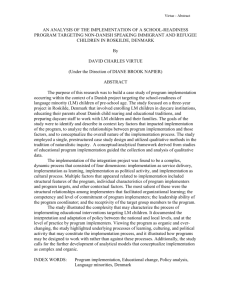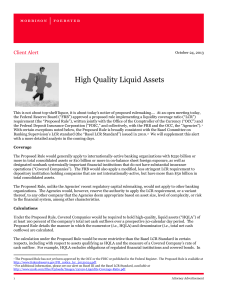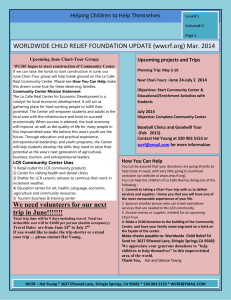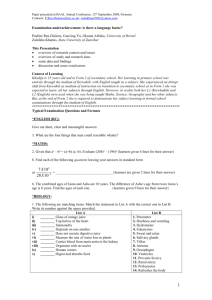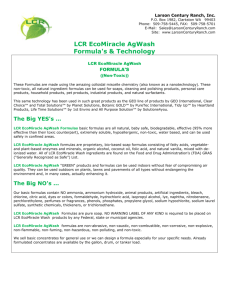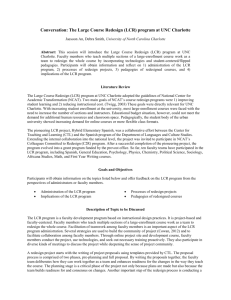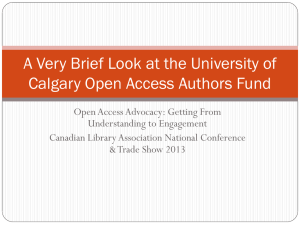Implementation Team
advertisement
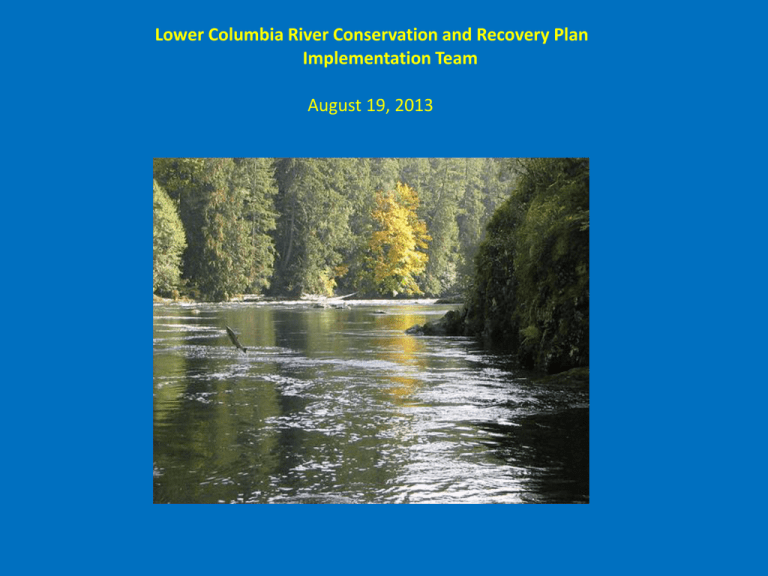
Lower Columbia River Conservation and Recovery Plan Implementation Team August 19, 2013 What is the role of the Implementation Team? • • • • • Who is the team? Why do we have a team? What does it mean to be on the team? What has the team done? What may the team do in the future? Who is the team? • A group of Lower Columbia River Stakeholders • Representing differing perspectives and missions • Ultimately having common objective of working together to achieve recovery plan goals Recovery Team (Policy, Overall Lead) Planning team reps, other key fed, state, local, Tribal Scientists, consultants University profs Chair: member of team or facilitator GNRO, ODFW, OWEB, Implementation Coordinator, Federal Partners, Tribes, Counties Staff: Chair: GNRO Implementation Coordinator Technical Team Implementation Team (Science/Technical) Stakeholder Team members Watershed Team reps, Other project implementers, NOAA, Tribes, Tech reps Chair: Imp. Coordinator Staff: Facilitator, NOAA (Schedules, tracking, Reporting, coordination Adaptive management, RM&E) Strata Teams Estuary LCREP Coast Cascade Gorge Why do we have a team? • The LCR Conservation and Recovery plan is voluntary • Success of meeting plan goals will take concerted effort by all interested and affected entities • Team members have the pulse of their local communities What are the roles of the team? • • • • To provide advice, recommendations and support to the IC To assist with communication and coordination with local implementers To assist with advancement of recovery goals and development of 3YIS Encourage local implementers to work toward recovery plan implementation and 3YIS goals • Assist local implementers in being more effective in implementation • Facilitate information exchange and provide education to local implementers regarding the LCR plan • Be a sounding board between local implementers and the IT team. What has the team done? • Currently the entire team meets one time per year to hear updates on the status of the LCR plan implementation. • Formed focused workgroup to assist with prioritization of habitat enhancement projects and develop the first 3YIS. • In the future team groups will be formed based upon past and present survey results. • Groups formed will be in the 6 general categories and meet on an as needed basis. • 2010 Survey re: location and group type interest Planning & Advisory Local C&R Actions Tracking & Reporting Purpose RM&E / Technical Funding Guidance Education & Outreach Survey from August 2010 • • • • 20/50 responses on the questionnaire Area of interest YB-2, BC-2, Clat-3, Scap-1, Clack-7, Sandy-7, LG and UG-0, HD-1 Group interest: P&A-11, FG-6, RME-8, LRA-11, E&O 4, T&R-5, NI-1 Wide variety of implementation needs/concerns you may have. Will cue those up on individual action. Lower Columbia Implementation Team Survey Name: Affiliation: Title: Address: Email: Phone: Which of following best describes your interests in the LCR Recovery Plan Implementation Team? Please check all that apply. Local Recovery Action Planning & Advisory Implementation Funding Guidance Education & Outreach RM&E/Technical Guidance Tracking & Reporting Other (please specify): I am not interested in participating on the Implementation Team In which basin(s) are you currently working in the LCR? Please list any organizations/lead contacts actively working in the LCR that you believe should be included on the LCR Implementation Team. 1) Organization, Name & Contact Info: 2) Organization, Name & Contact Info: 3) Organization, Name & Contact Info: What is the plan for the team moving forward? • Anticipate forming Local Recovery Action Implementation Team (s?) to assist identification of high priority projects where needed. • Plan to form workgroups to discuss top 2 or 3 plan actions as determined by the 2013 survey, if interest can open re-survey. • Engaging local implementers to determine if they can participate in high priority projects or assist with identification of the highest priority actions they could undertake and in the highest priority areas. Is what I am doing contributing to the plan? • If you are here and working in some capacity to create a better environment for listed fish species the answer is most likely YES! • There are 308 actions listed in the plan some are global and some are basin specific. • Not every action can be considered a high priority but attempts are made to capture contributions for all actions. • Eventually all actions will need to be addressed in order to achieve the goals of the plan. • I hope the team can assist with local agencies/municipalities/ect to carry the message that they ought to work within the highest priority action and area that fits within their missions. • I hope the team can gain assistance when possible from these other groups to help implement high priority projects they are conducting. April 2013 Survey Results • • • • • • • • • • • • • • • • Working with land managers to develop scenarios that reduce affects to the hydrograph from runoff Development of storm water management for urban areas and roads Enhanced protection for high quality habitat Mitigation of impacts within High Intrinsic Potential habitat Methodology to assess and ID population strongholds which are resilient to climate change. Methods to conduct and implement sediment source analysis in watersheds. streamlining the permit process LWD projects not covered under the State Forest Practices Act How do we achieve the LWD goals in the plan Creation of LWD banks Local workshops to develop conceptual high priority projects Reaching out beyond the watershed councils about recovery plan goals Riparian workshops for volunteers Incentives for habitat restoration Ecosystem markets Channel Migration Zone and FP development 12 Responses; Mixed Message in Survey Request; Need to Re-do Survey Response-Mark only 3, Rank 1-3 1. Incentives for Habitat Restoration Response-Mark all and give 1. Enhance protection of high quality rank 1-3 habitat 2. Assess Stronghold pop's resiliant to climate change 2. Channel migration zone and FP issues 3. How to achieve LWD goals in the plan 3. Mitigation of impacts w/in HIP habitat Questions?
